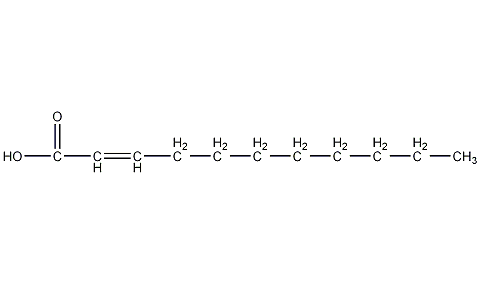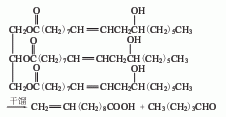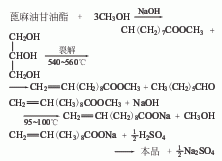
Structural formula
| Business number | 035L |
|---|---|
| Molecular formula | C11H20O2 |
| Molecular weight | 184.28 |
| label |
Undecylenic acid, Undec-10-enoic acid, fragrance, acidic solvent |
Numbering system
CAS number:112-38-9
MDL number:MFCD00004442
EINECS number:203-965-8
RTECS number:YQ2975000
BRN number:1762631
PubChem number:24856513
Physical property data
1. Properties: Colorless or light yellow liquid with special smell
2. Density (g/mL, 25℃): 0.9072
3. Relative density ( 20℃, 4℃): 0.907224
4. Melting point (ºC): 24.5
5. Boiling point (ºC, normal pressure): 275
6. Refractive index at room temperature (n20): 1.447225
7. Refractive index (n sub>25D): 1.4464
8. Flash point (ºC): 148
9. Refractive index at room temperature ( n25): 1.445730
10. Autoignition point or ignition temperature (ºC): Undetermined
11. Vapor pressure (mmHg, 70ºC): Undetermined
12. Saturated vapor pressure (kPa, ºC): Undetermined
13. Heat of combustion (KJ/mol): Undetermined
14. Critical temperature (ºC): Undetermined
15. Critical pressure (KPa): Undetermined
16. Oil and water (octanol/water) distribution Log value of coefficient: Undetermined
17. Explosion upper limit (%, V/V): Undetermined
18. Explosion lower limit (%, V/V): Undetermined
19. Solubility: Almost insoluble in water, soluble in ethanol, ether, chloroform and other organic solvents
Toxicological data
Acute toxicity:
Oral LD50 8150mg/kg(mus)
2500mg/kg(rat)
Skin irritation severe 500mg/24H(rbt)
Main irritating effects:
On the skin: Irritating the skin and mucous membranes.
On the eyes: irritating effects.
Sensitization: No known sensitizing effects.
Ecological data
General notes
Generally not hazardous to water
Do not discharge material into the surrounding environment without government permission.
Molecular structure data
1. Molar refractive index: 54.63
2. Molar volume (cm3/mol): 198.3
3. Isotonic specific volume (90.2K ): 478.7
4. Surface tension (dyne/cm): 33.9
5. Polarizability (10-24cm3): 21.65
Compute chemical data
1. Reference value for hydrophobic parameter calculation (XlogP): None
2. Number of hydrogen bond donors: 1
3. Number of hydrogen bond acceptors: 2
4. Number of rotatable chemical bonds: 9
5. Number of tautomers: none
6. Topological molecule polar surface area 37.3
7. Number of heavy atoms: 13
8. Surface charge: 0
9. Complexity: 141
10. Number of isotope atoms: 0
11. Determine the number of atomic stereocenters: 0
12. Uncertain number of atomic stereocenters: 0
13. Determine the number of chemical bond stereocenters: 0
14. Number of uncertain chemical bond stereocenters: 0
15. Number of covalent bond units: 1
Properties and stability
1. Avoid contact with strong oxides.
2.This product has low toxicity and slight irritation. The oral LD50 for rats is 2500mg/kg. Operators should wear protective equipment.
3. Exist in smoke.
4. The original document does not specify the position of the olefinic bond, and the content here refers to 10-undecenoic acid.
Storage method
1. Packed in lead barrels or plastic barrels.
2. Packed in aluminum barrels or plastic barrels, each barrel weighs 20kg, 50kg or 100kg.
Synthesis method
It is produced by direct pyrolysis or esterification pyrolysis of castor oil.
1. Castor oil direct cracking method: Put the castor oil into a stainless steel reaction pot, heat it under direct fire, carbonize under reduced pressure, collect the distillate, and then fractionate to obtain undecylenic acid and heptanoic acid.

2. Ricinoleate methyl ester method castor oil (Ricinoleic acid glyceryl ester) is transesterified with methanol, and then cracked at high temperature to obtain methyl undecylenate, which is then saponified; after acidification and refining, the finished product is obtained, and heptanal, glycerin and other products are by-produced.
Raw material consumption quota: castor oil (medicinal) 4700kg/t; methanol (industrial product) 1410kg/t; sulfuric acid (industrial product) 658kg/t; caustic soda (95%) 40kg/t; sodium bisulfite ( 95%) 940kg/t.

Purpose
1. It is an important raw material for the synthesis of fragrances, such as γ-laurolactone (also known as peach aldehyde), polycyclopentadecanolactone, muscone, nonanal, etc. It can also be used as antifungal drugs and drugs to treat skin mycosis, and can synthesize surfactants with antibacterial properties such as sodium undecyl monoethanolamide succinate sulfonate. It can also be used to prepare plasticizers, etc. The maximum allowable usage amount (mass fraction) in cosmetics is 0.2%, and it is stable in the pH range of 5.0 to 6.5. The dosage (mass fraction) used as a pharmaceutical antifungal agent is 2% to 15%.
2.is an important raw material for synthetic fragrances, such as γ-undecanolide, polycyclopentadecanolactone, and musk Ketones, nonanal and nonanol can also be used as raw materials for antibiotics and drugs for treating skin mycosis.

 微信扫一扫打赏
微信扫一扫打赏

